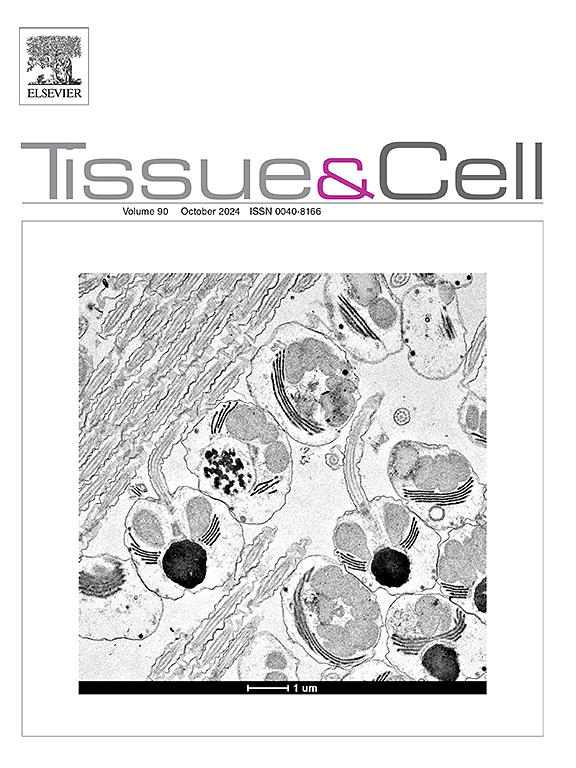Morphology of the head-associated exocrine glands in Cornitermes cumulans with the description of a novel gland for the worker caste
IF 2.5
4区 生物学
Q1 ANATOMY & MORPHOLOGY
引用次数: 0
Abstract
Exocrine glands are important mediators of communication in eusocial insects and the description of novel glands reflects the complex context in which these animals live. Here we revisit the head-associated glands in workers of the Neotropical termite Cornitermes cumulans through histological analysis and describe a novel gland for this caste, the intramandibular glands. This structure is located underneath the cuticle of the dorsodistal part of each mandible. The glands showed an epithelial arrangement, but the cytological morphology is complex, comprising classes I and III of secretory cells. The present data highlight the importance of the intramandibular glands in the worker caste and demonstrate different morphology of these glands in Isoptera, probably related to the specialized function of the castes. Features of active glandular activity were also observed in the mandibular, labral, and salivary glands of these workers. Despite the intramandibular glands being also found in workers of other social insects, their occurrence in termites was restricted to the soldier caste of Machadotermes. Even so, their cytological structure differs from those of C. cumulans workers. The likely function of the worker intramandibular glands is discussed considering the separate-nest life type present by C. cumulans and tasks performed by workers. The chemical nature of the secretion and the occurrence of the glands in other termite taxa still require further investigation.
积雨蜂头部相关外分泌腺的形态与工人阶层新腺体的描述。
在群居昆虫中,外分泌腺是重要的交流媒介,对这些新腺体的描述反映了这些动物生活的复杂环境。在这里,我们通过组织学分析重新审视了新热带白蚁蚁头相关腺体,并描述了这个种姓的一种新的腺体,下颌内腺。这个结构位于每个下颌骨背远端角质层的下方。腺体呈上皮状排列,但细胞学形态复杂,包括I类和III类分泌细胞。目前的数据强调了工人阶层下颌内腺的重要性,并证明了这些腺体在等翅目中的不同形态,可能与种姓的特殊功能有关。在这些工人的下颌、唇和唾液腺中也观察到活跃的腺体活动特征。尽管在其他群居昆虫的工蚁中也发现了下颌内腺,但它们在白蚁中的出现仅限于马查多白蚁的士兵种姓。尽管如此,它们的细胞学结构与积云工蜂不同。考虑到积云蚁的分离巢生活类型和工蚁的任务,讨论了工蚁下颌内腺的可能功能。分泌物的化学性质和腺体在其他白蚁类群中的发生情况仍需进一步研究。
本文章由计算机程序翻译,如有差异,请以英文原文为准。
求助全文
约1分钟内获得全文
求助全文
来源期刊

Tissue & cell
医学-解剖学与形态学
CiteScore
3.90
自引率
0.00%
发文量
234
期刊介绍:
Tissue and Cell is devoted to original research on the organization of cells, subcellular and extracellular components at all levels, including the grouping and interrelations of cells in tissues and organs. The journal encourages submission of ultrastructural studies that provide novel insights into structure, function and physiology of cells and tissues, in health and disease. Bioengineering and stem cells studies focused on the description of morphological and/or histological data are also welcomed.
Studies investigating the effect of compounds and/or substances on structure of cells and tissues are generally outside the scope of this journal. For consideration, studies should contain a clear rationale on the use of (a) given substance(s), have a compelling morphological and structural focus and present novel incremental findings from previous literature.
 求助内容:
求助内容: 应助结果提醒方式:
应助结果提醒方式:


